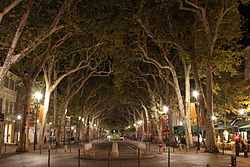Cours Mirabeau

The Cours Mirabeau is a wide thoroughfare in Aix-en-Provence, France.
Overview
440 meters long and 42 meters wide, the Cours Mirabeau is one of the most popular and lively places in the town. It is lined with many cafés, one of the most famous being Les Deux Garçons and during its history frequented by famous French cultural figures such as Paul Cézanne, Émile Zola and Albert Camus.
The street has wide sidewalks planted with double rows of plane-trees. The Cours Mirabeau is decorated by fountains, the most notable of which is La Rotonde, a large fountain that makes up a roundabout at one end of the street. The street also divides Aix into two portions, the Quartier Mazarin, or "new town", which extends to the south and west, and the Ville comtale, or "old town", which lies to the north with its wide but irregular streets and its old mansions dating from the 16th, 17th and 18th centuries.
History
From 1646 onwards, rich locals started moving into the Mazarin quarter, built by Michele Mazzarino (1605 - 1648), known as "Michel Mazarin", the Dominican who was appointed Archbishop of Aix-en-Provence in 1645 by Pope Innocent X. Mazzarino had been professor of theology at the College of Saint Thomas, the future Pontifical University of Saint Thomas Aquinas, Angelicum in Rome, and Master of the Sacred Palace under Pope Urban VIII in 1642. Mazzarino was also the brother of Giulio Mazzarino, known as "Jules Mazarin" who served as chief minister under Louis XIV of France.[1]
In 1650, the Parliament of Aix-en-Provence commissioned the building of a thoroughfare for carts where there was a crumbled rempart.[1] The idea was for it to become the new place of dalliance for Aix dwellers, instead of the place des Prêcheurs.
The thoroughfare cost 100,000 pounds, and was paid for by property buyers, the town (15,000 pounds), Provence communes (20,000 livres) and Louis, Duke of Vendôme.
A long enclosure closed off by remparts, town houses were gradually built on each side. A balustrade would look to fields and gardens downwards.
By 1696 four fountains had been built : Fontaine des 9 canons, Fontaine "Moussue, Fontaine du Roi René and, to the west, "les Chevaux-Marins", now vanished.
Whilst he first thought of building a palace there, the Duke of Vendôme came around and decided on the 'wildness of fields'. Instead he commissioned the Pavillon Vendôme, where he died in 1669. His son, Louis Joseph de Vendôme (1654–1712), sold their part of the Cours Mirabeau back to Pierre de Creissel, who sold it again to four buyers, thus dividing it into four town houses.
In 1876, Patrice de Mac-Mahon (1808-1893) signed a decree for it to be named after Honoré Gabriel Riqueti, comte de Mirabeau.
References
- Henry W. Lawrence (2008). City Trees: A Historical Geography from the Renaissance Through the Nineteenth Century. University of Virginia Press. pp. 36–7. ISBN 0813928001.
External links
| Wikimedia Commons has media related to Cours Mirabeau. |